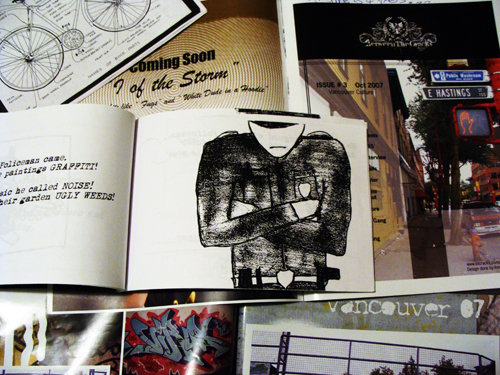What's in a zine?
It’s tough getting your ideas immortalized in print. Between heavy-handed editors, corporate publishers, and uncertain distribution (not to mention a…
It’s tough getting your ideas immortalized in print.
Between heavy-handed editors, corporate publishers, and uncertain distribution (not to mention a less-than-booming economy) sharing the printed word has become an uphill battle for even the most affluent authors.
But while media monoliths like Time Warner continue to disseminate People Magazine by the truckload—reaching a weekly circulation of 3.75 million—on the opposite end of the spectrum there are zines. Often armed with some paper, a stapler, and a public photocopier, zine makers (affectionately known as zinesters) publish tales from the fringes, often reaching the eyes of less than 100 viewers.
Yes, zines have contributed to unique small-scale conversations in the Downtown Eastside and around the world without the help of glossy stock, colour ink or even a functioning typewriter in some cases. And while the zine phenomenon isn’t exactly cutting-edge in 2009, it is new to the Vancouver Public Library catalogue.

The downtown branch of the VPL has recently launched a collection of zines. These non-profit DIY publications host a range of topics, from bicycle maintenance and single motherhood to dealing with sexual abuse.
According to Caroline Crowe of the VPL, these zines “tap into segments of the population who generally feel disenfranchised from the library or from traditional media.” A recent Megaphone article goes on to say Crowe hopes people who feel socially and economically marginalized will be able to find material in zines not otherwise available to them. The collection could even inspire other underrepresented people, such as the Downtown Eastside community, to express themselves.
I checked out the VPL zines for myself, and sure enough found a number of zines relating to Canada’s poorest postal code. While glossier fare like Between the Cracks profiled the best in East Van street art, other zines like Anna’s Story illustrate very personal stories of poverty and police intervention.
Anna is a small girl in the poorest part of East Vancouver, who plants some tomato seeds in an abandoned lot. Although the makeshift garden becomes a spot where people come together to make art and music, a policeman comes with a bulldozer to ‘clear out the mess.’ In the end, Anna stands up to the bulldozer and saves the community garden.
While Anna’s Story is compelling and alternative, it is also quite childish.
I found the problem with this particular zine—and many other similar zines—was it presented a grave oversimplification of the relationship between poor residents and police forces. I’ve since learned zines do not by nature provide engaging and artful material, they are merely alternative in publication and distribution.
However, if you’re interested in browsing the VPL’s newly acquired zine collection, they are on the first floor of the central branch, right between graphic novels and the payphones.

Comments
While sometimes ‘zines greatest strength (anyone can make them!) is also their greatest enemy (get these kids an editor!), dismissing all of them as not engaging or artful is unfair. Some ‘zines are engaging and artful, you just have to find the right ones, like any media.